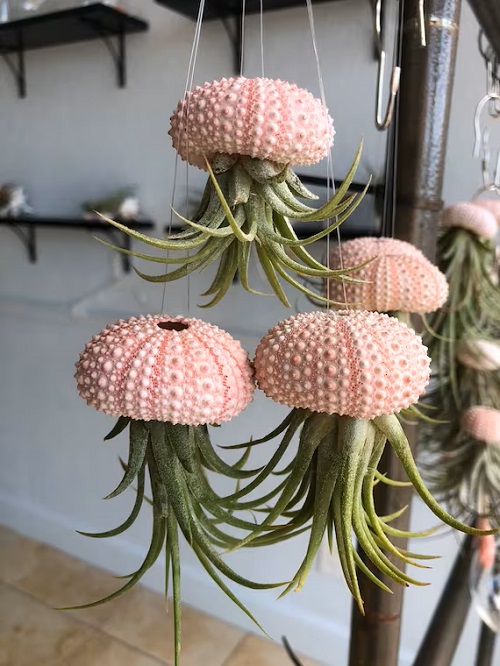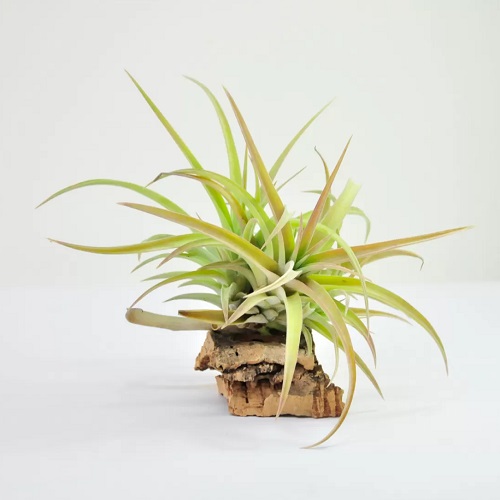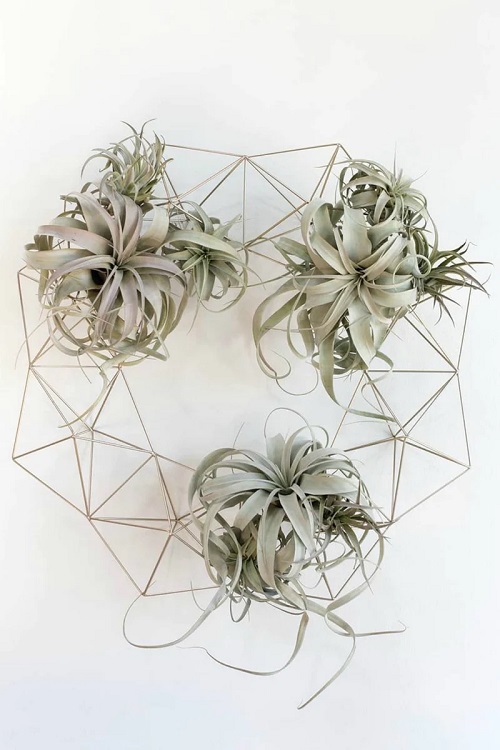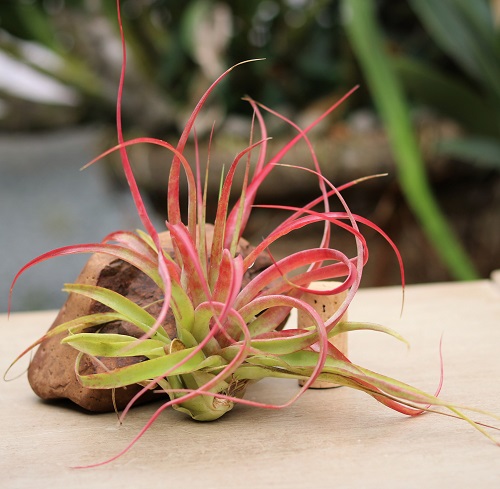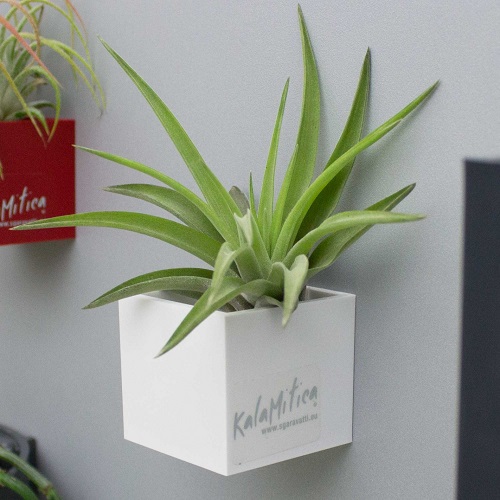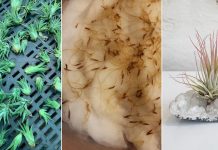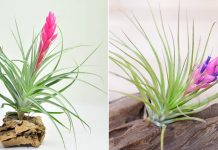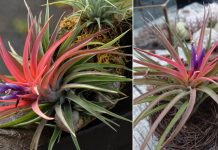Read The Best Jellyfish Air Plant Care Guide on The Internet, your ultimate guide with easy tips and tricks for thriving air plants.
The Jellyfish Air Plant stands out as a fascinating choice for novice and seasoned gardeners. With its distinctive appearance and relatively low maintenance requirements, this plant has garnered attention for its ability to add a touch of enchantment to indoor and outdoor spaces. Check Out our Jellyfish Air Plant Care Guide and make a remarkable addition to your indoors.
- Botanical Name: Tillandsia ‘Jellyfish’
- Popular as- Jellyfish Air Plant, Airplant ‘Jellyfish’
- Thrives in bright, indirect light.
- Grows well in temperature range of 50-90°F (10-32°C)
- Non-toxic to humans and pets
Check Out Tillandsia Magnusiana Care and Growing Here
What is the Jellyfish Air Plant
The Jellyfish Air Plant is a captivating epiphytic plant that belongs to the Bromeliad family. Its name is inspired by its unique resemblance to the graceful tendrils of a jellyfish suspended in the air. This extraordinary plant features slender, trailing leaves that create a delicate, cascading effect, perfectly capturing the essence of an aquatic jellyfish.
The Jellyfish Air Plant showcases a distinct, umbrella-like form with elongated, curving leaves that drape downwards. Its foliage displays a stunning blend of shades, transitioning from lush green at the base to a subtle silver hue toward the tips. Measuring 6 to 8 inches in height, it is an ideal candidate for terrariums, hanging planters, or unique displays.
Find Where Do Air Plants Come From
Jellyfish Air Plant Propagation
Methods to Propagate Jellyfish Air Plant:
- Division/Offsets
- Seeds
Propagation of the Jellyfish Air Plant is primarily achieved through a technique known as division. This method allows gardeners to create new plants from the offsets produced by the parent plant.
- Look for small offsets that have grown at the base of the mature air plant. These are miniature versions of the parent plant and can be easily separated for propagation.
- Lay down some paper towels or a clean cloth to catch any debris and provide a clean surface for your propagation.
- Gently grasp the base of an offset and wiggle it back and forth to loosen it from the parent plant. Use your fingers to pull the offset away from the parent plant carefully. If the offset doesn’t easily come off, you can use clean scissors or pruning shears to snip it off close to the parent plant’s base.
- Place the separated offset in a dry location for a few hours to a day. This helps the cut end to callous over.
- Instead of using soil, air plants are typically mounted on various surfaces. You can attach the offset to a piece of wood, a decorative rock, or any other creative substrate. Use waterproof glue, wire, or even natural materials like cotton thread to secure the offset to the chosen surface.
- After mounting the offset, mist it lightly with water to provide some humidity. Place it in a location with bright, indirect light. Avoid direct sunlight, as it can cause the plant to dry out or get sunburned.
Regular Care: Mist the mounted offset and the substrate with water 1-2 times a week or as needed, depending on the humidity of your environment. As the offset grows, it will develop its own roots, and you can gradually reduce misting.
Find What Does a Healthy Air Plant Look Like?
Jellyfish Air Plant Flower
The Jellyfish Air Plant’s beauty isn’t confined to its foliage alone. It also produces captivating blooms that add a touch of elegance to its already enchanting appearance. Its flower is characterized by its vibrant and eye-catching appearance. The inflorescence emerges from the center of the plant, often rising above the trailing leaves.
The blooms are composed of delicate, tubular flowers in various colors, including purple, pink, and red shades. The Jellyfish Air Plant typically enters its flowering phase during the warmer months. Spring and early summer are the prime seasons for the plant to produce striking blooms.
Read Tillandsia Magnusiana Care and Growing
Jellyfish Air Plant Varieties
1. Tillandsia Capitata Peach
With its striking peachy hue and elongated, feathery leaves, Tillandsia Capitata Peach adds a touch of warmth to any arrangement. This variety features a graceful upward growth habit, making it an excellent choice for hanging displays.
2. Tillandsia Ionantha Rubra
Known for its compact size and vibrant red tones, Tillandsia Ionantha Rubra is a delightful addition to small spaces or terrariums. Its leaves blush crimson during blooming, contrasting beautifully with its green base.
3. Tillandsia Xerographica
The regal Tillandsia Xerographica boasts stunning silvery-gray foliage that curls and twists elegantly, resembling a rosette. This air plant is revered for its dramatic appearance and ability to capture a sense of timeless elegance. As it matures, Xerographica develops a captivating tangle of tendrils, creating a captivating focal point in any display.
4. Tillandsia Brachycaulos Abdita
Exhibiting a captivating blend of green and hints of red, Tillandsia Brachycaulos Abdita brings a pop of color to your collection. Its leaves gracefully arch, forming a compact rosette that takes on richer tones during its blooming period.
5. Tillandsia Velutina
With its soft, velvety appearance and exquisite trichomes, Tillandsia Velutina exudes a unique tactile charm. This variety features a compact size and captivating shades of green, transitioning to pink and purple during flowering.
Find How to Care for Air Plants
Feeding Jellyfish Air Plants
Jellyfish Air Plants primarily absorb nutrients from the air and water, making them well-suited to their epiphytic nature. Feeding jellyfish air plants is a simple process. The primary method involves using a diluted, water-soluble fertilizer. Mix a balanced, liquid fertilizer with water, following the manufacturer’s recommended dosage. Once a month, gently mist the diluted fertilizer onto the foliage of the jellyfish air plant, ensuring complete coverage.
You can also soak the plant in the diluted fertilizer solution for about 20-30 minutes. Additionally, these plants can absorb nutrients from the environment, so they don’t rely heavily on feeding. Generally, a monthly feeding during the growing season (spring and summer) should support healthy growth.
Explore the Amazing Benefits of Air Plants
Jellyfish Air Plant Care
Position
Place your Jellyfish Air Plant in bright, indirect light. Avoid direct sunlight, as it can scorch the delicate foliage. Optimal locations include near windows with sheer curtains or a few feet away from artificial light sources. (explain)
Water
Mist your Jellyfish Air Plant with water two to three times a week. Ensure the plant receives a thorough misting, allowing water to reach the leaves and base. In drier environments, increase the frequency of misting to prevent dehydration.
Temperature and Humidity
Maintain a temperature range of 50-90°F (10-32°C) to provide the Jellyfish Air Plant with the comfort it needs to thrive. Protect the plant from extreme temperature fluctuations and drafts. The Jellyfish Air Plant thrives in moderate to high humidity environments. To enhance humidity, mist the plant regularly or place it in a well-ventilated terrarium or enclosure.
Pests and Diseases
Keep an eye out for common pests such as mealybugs and aphids. Regularly inspect your plant for signs of infestation, such as white cotton-like substances or tiny insects. If detected, gently remove pests using a soft brush or a cotton swab dipped in alcohol. Preventative measures, such as maintaining proper airflow and hygiene, can help prevent these issues.
Find Do Air Plants Need Sun?
Jellyfish Air Plant Display Ideas
1. Driftwood Delight
Arrange plants of varying sizes along the length of the driftwood, allowing their tendrils to cascade gracefully. Hang this captivating arrangement near a window to catch the sunlight and create a mesmerizing play of shadows.
2. Seashell Serenity
Transform seashells into enchanting homes for your jellyfish air plants. Nestle’s small air plants within iridescent seashells’ curves create a captivating underwater-inspired vignette. Arrange these delicate compositions on a windowsill or mantelpiece for a touch of coastal charm.
3. Floating Glass Orbs
Suspend jellyfish air plants within clear glass orbs for a whimsical suspended garden. These transparent orbs magnify the intricate details of the plants while adding a touch of elegance. Hang them in clusters at different heights to create a stunning visual focal point.
4. Terrarium Tranquility
Craft an intricate terrarium featuring a central jellyfish air plant as the centerpiece. Surround it with a bed of pebbles, decorative stones, and miniature figurines to create a whimsical microcosm.
5. Hanging Macramé
Combine the art of macramé with the elegance of jellyfish air plants. Create a hanging display using macramé plant hangers, allowing the plants to dangle mid-air.
6. Vertical Garden Wall
Transform a blank wall into a living work of art by arranging multiple jellyfish air plants on vertical wall-mounted planters. Vary the sizes and types of plants for an eye-catching display that combines botanical beauty with modern design.
Read Tillandsia Flexuosa Vivipara – Everything About it and How to Grow it
Jellyfish Air Plants FAQs
Q.1. How often should I water my jellyfish air plants?
Like other Tillandsia varieties, jellyfish air plants thrive with a misting regimen. Spritz them with water every 1-2 weeks, lightly moistening their foliage. Adjust the frequency based on humidity levels and climate to prevent water from pooling at the base to avoid rot.
Q.2. Can I place jellyfish air plants in direct sunlight?
While jellyfish air plants appreciate bright light, they’re best suited for indirect sunlight. Avoid placing them in direct sun, which can scorch their delicate leaves. Opt for bright, filtered light near windows or under sheer curtains to maintain their health and vibrancy.
Q.3. How do I revive a dehydrated jellyfish air plant?
If your jellyfish air plant appears dehydrated, give it a revitalizing soak. Submerge the entire plant in room-temperature water for 20-30 minutes. After soaking, gently shake off excess water and let it air-dry upside-down to prevent water from pooling at the base.

